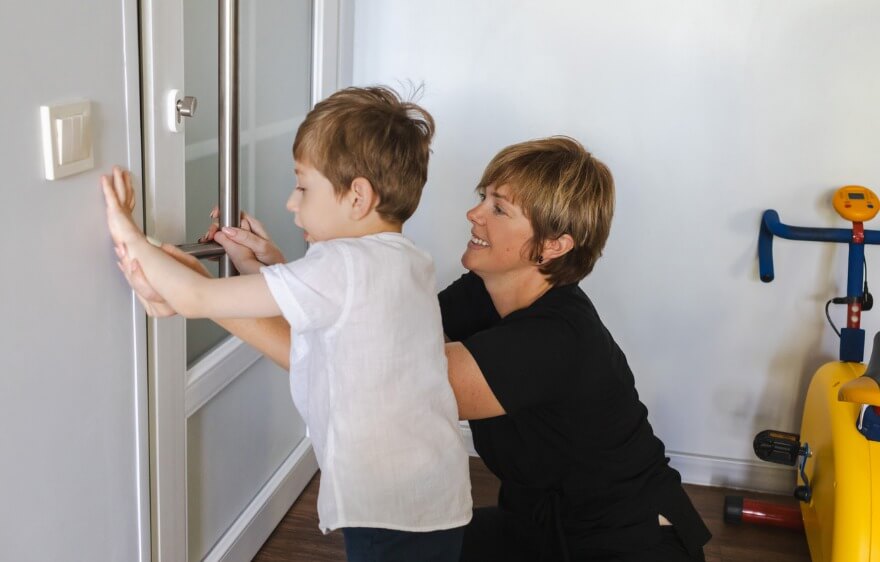As a parent, you want nothing but the best for your child. You want your kiddo to be able to thrive in their daily activities, communicate effectively with others, and develop the skills necessary for a bright future. For children who are challenged with certain tasks or activities, therapy can provide a structured, evidence-based path to support growth that can help your family thrive — but it’s natural to have questions about which specific approach is the best fit.
In particular, occupational therapy versus speech therapy is a common comparison many parents find themselves making if they feel their child may need extra help in certain areas. Understanding the key differences between the two and what each type of therapy focuses on can guide your decision. To help, we’re exploring occupational therapy versus speech therapy with an in-depth look at how to determine which one may be right for your child. Let’s dive in!
What Is Occupational Therapy?
Occupational therapy(OT) is a therapeutic approach focusing on helping individuals of all ages develop, improve, or regain the skills needed for everyday activities or occupations. This can include tasks such as dressing, eating, playing, writing, and even personal hygiene. Occupational therapy helps children with physical, sensory, cognitive, or developmental challenges that affect their ability to participate in these routine tasks.
OT can address a wide variety of issues, including difficulties with fine motor skills such as hand-eye coordination or pencil grip, sensory processing disorders such as sensitivity to lights or textures, or motor planning issues such as knowing how to carry out multi-step tasks. The ultimate goal of occupational therapy is to help children achieve greater independence and participate fully in the activities they enjoy and need to do in their daily lives.
What Does Occupational Therapy Help With?
Occupational therapy helps children with a wide range of difficulties, including:
- Fine Motor Skills: These include tasks like holding a pencil, cutting with scissors, buttoning a shirt, or tying shoes.
- Sensory Processing: Some children have difficulty processing sensory input like light, sound, touch, or movement. OT can help children better understand and manage sensory overload or under-reactivity through interventions such as a sensory diet.
- Gross Motor Skills: These skills involve large muscle groups and activities such as running, jumping, or climbing.
- Cognitive Skills: Occupational therapists can help children with planning and organization, completing tasks, or following multi-step instructions.
- Self-care Skills: OT supports children in developing skills for personal care, including dressing, brushing teeth, and eating independently.
- Social Skills: Occupational therapists can also help children work on their interactions with others, fostering better communication and play.
Signs Your Child Needs Occupational Therapy
It’s important to be aware of signs that may indicate your child would benefit from occupational therapy. Here are some common signs to look for:
- Difficulty with fine motor skills, like holding a pencil or using utensils
- Challenges in self-care tasks like dressing, feeding, or toileting
- Sensory sensitivities, such as becoming overwhelmed by certain textures, lights, sounds, or smells
- Trouble with gross motor coordination, such as walking, running, or jumping
- Difficulty with focus or attention to tasks
- Trouble engaging in or participating in play with peers
- Struggling with multi-step tasks or organizing activities
If your child exhibits these behaviors, it might be worth considering an evaluation for occupational therapy.
What Is Speech Therapy?
Speech therapy is another type of therapeutic intervention that focuses on helping individuals improve their communication skills. Speech-language pathologists (SLPs) work with children who have difficulties with speech, language, communication, or swallowing. The goal of speech therapy is to help children develop or improve their ability to express themselves and understand others in a meaningful way.
While speech therapy is most commonly associated with speech sound issues, it also encompasses a variety of other areas such as language comprehension, articulation, voice control, and even social communication. Speech therapists also help children who have difficulty swallowing, which can affect their ability to eat and drink safely.
What Does Speech Therapy Help With?
Speech therapy uses evidence-based techniques to help with a wide range of communication challenges, including:
- Speech Articulation: Helping children pronounce sounds or words correctly.
- Language Development: Working on vocabulary, grammar, sentence structure, and understanding language.
- Social Communication: Teaching children how to engage in appropriate conversations, take turns, and understand non-verbal cues such as facial expressions or body language.
- Voice Disorders: Addressing issues with pitch, volume, or quality of voice.
- Swallowing and Feeding: Helping children with difficulties in chewing, swallowing, or safe eating.
- Fluency: Addressing stuttering or other issues with speech flow.
Signs Your Child Needs Speech Therapy
There are a few key signs that may indicate your child could benefit from speech therapy. Look for the following:
- Difficulty pronouncing certain sounds or words clearly
- Trouble following directions or understanding language
- Challenges with social communication, such as difficulty making friends, staying on topic, or understanding body language
- Persistent stuttering or other fluency issues
- Difficulty with swallowing or feeding, such as choking or gagging
- A delay in speech and language milestones, such as limited vocabulary for their age
If your child is showing any of these signs, it may be helpful to schedule an evaluation with a speech therapist.
Occupational Therapy vs Speech Therapy: What’s the Difference?
At first glance, occupational therapy versus speech therapy may seem to overlap in some areas, especially when it comes to communication or social skills. However, there are key differences that set these therapies apart.
1. Focus
- Occupational therapy focuses on the skills needed to perform everyday activities or occupations such as dressing, eating, playing, and interacting. It addresses fine and gross motor skills, sensory processing, and cognitive abilities.
- Speech therapy is specifically focused on communication and swallowing. It includes improving articulation, language skills, social communication, voice production, and feeding or swallowing difficulties.
2. Target Areas
- Occupational therapy deals with physical, sensory, and cognitive challenges. An OT might address how children use their hands or body in daily activities, how they handle sensory input, or how they plan and organize tasks.
- Speech therapy primarily addresses how a child produces and understands speech. It works on communication, including both expressive language, what a child says, and receptive language, how well they understand what others say.
3. Therapeutic Techniques
- Occupational therapists often use hands-on activities and even games and toys to work on strengthening muscles and improving fine motor control. They may incorporate sensory experiences, visual or auditory stimuli, and various strategies to improve day-to-day functioning.
- Speech therapists typically use exercises and activities focused on sound production, language development, and social interaction. They may engage children in conversation, storytelling, and various other language-rich activities.
4. Ages and Stages
- Occupational therapy can be beneficial for children of all ages, from infants learning how to feed themselves to school-aged children struggling with handwriting or motor coordination.
- Speech therapy also works with children of all ages but is primarily focused on verbal and non-verbal communication challenges.
Occupational Therapy vs Speech Therapy — Which Is Right for Your Child?
Now that we’ve explored occupational therapy versus speech therapy, you may be wondering which one is right for your child. The answer depends on your child’s specific needs.
- If your child is struggling with motor skills, such as difficulty using their hands for fine tasks like writing or drawing, or they are having trouble with balance and coordination in activities like jumping or climbing, occupational therapy might be the right choice.
- If your child is having trouble communicating, whether that means issues with speech clarity, language comprehension, or social interactions, speech therapy could be the best fit.
- It’s also possible that your child might benefit from both therapies. Many children have overlapping needs that require support in multiple areas, and both therapies can work together to help your child succeed.
Ultimately, the best course of action is to seek guidance from a pediatrician or therapist who can assess your child’s needs and recommend the most appropriate intervention. Early intervention is key to helping children reach their full potential. In some cases, a treatment plan will include both speech therapy and occupational therapy.
Occupational Therapy vs Speech Therapy — Making the Right Choice for You
The question of occupational therapy versus speech therapy is a common one for parents, and there is no one-size-fits-all answer. Both types of therapy address different aspects of a child’s development and can help them overcome challenges they might be facing. By understanding the goals and methods of each type of therapy, you can make an informed decision about what’s best for your child.
Remember, early intervention is often the key to success, so don’t hesitate to reach out to professionals who can guide you through the process and support your child’s development. Whether your child needs occupational therapy or speech therapy — or both — rest assured that these therapies can provide the tools they need to thrive.
Schedule Your Child’s Care Assessment Today
At Care Options for Kids, we understand the unique challenges of caring for a child with health conditions. Our dedicated team of pediatric home health therapists is here to support your family with compassionate, expert care tailored to your child’s needs. Contact us today to schedule an assessment and learn how we can help you navigate this journey with confidence and care.
Click here to start your journey to better care.
This post is for educational and informational purposes only. You should always speak with your own therapist before implementing this information on your own.






